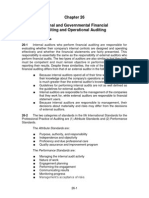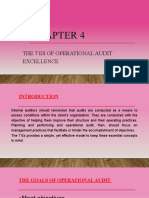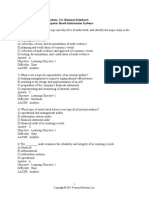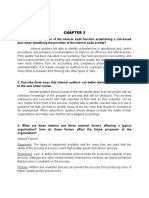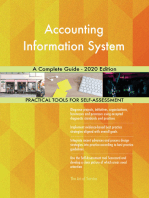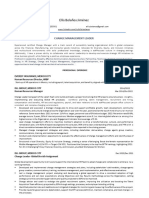Cisa Test Bank Part 1
Cisa Test Bank Part 1
Uploaded by
JEP WalwalCopyright:
Available Formats
Cisa Test Bank Part 1
Cisa Test Bank Part 1
Uploaded by
JEP WalwalOriginal Description:
Copyright
Available Formats
Share this document
Did you find this document useful?
Is this content inappropriate?
Copyright:
Available Formats
Cisa Test Bank Part 1
Cisa Test Bank Part 1
Uploaded by
JEP WalwalCopyright:
Available Formats
CISA TEST BANK PART 1
1. The development of an IS security policy is ultimately the responsibility of the:
A. IS department.
B. security committee.
C. security administrator.
D. board of directors.
2. To minimize costs and improve service levels an outsourcer should seek which of the following contract clauses?
A. O/S and hardware refresh frequencies
B. Gain-sharing performance bonuses
C. Penalties for noncompliance
D. Charges tied to variable cost metrics
3. Involvement of senior management is MOST important in the development of:
A. strategic plans.
B. IS policies.
C. IS procedures.
D. standards and guidelines.
4. An IS auditor should be concerned when a telecommunication analyst:
A. monitors systems performance and tracks problems resulting from program changes.
B. reviews network load requirements in terms of current and future transaction volumes.
C. assesses the impact of the network load on terminal response times and network data transfer rates.
D. recommends network balancing procedures and improvements.
5. The output of the risk management process is an input for making:
A. business plans.
B. audit charters.
C. security policy decisions.
D. software design decisions.
6. The risks associated with electronic evidence gathering would MOST likely be reduced by an e-mail:
A. destruction policy.
B. security policy.
C. archive policy.
D. audit policy.
7. An IT steering committee should review information systems PRIMARILY to assess:
A. whether IT processes support business requirements.
B. if proposed system functionality is adequate.
C. the stability of existing software.
D. the complexity of installed technology.
EXPLANATION: The role of an IT steering committee is to ensure that the IS department is in harmony with the organization's
mission and objectives. To ensure this, the committee must determine whether IS processes support the business
requirements. Assessing proposed additional functionality and evaluating software stability and the complexity of technology
are too narrow in scope to ensure that IT processes are, in fact, supporting the organization's goals.
8. An IS auditor reviewing an organization's IT strategic plan should FIRST review:
A. the existing IT environment.
B. the business plan.
C. the present IT budget.
D. current technology trends.
9. As an outcome of information security governance, strategic alignment provides:
A. security requirements driven by enterprise requirements.
B. baseline security following best practices.
C. institutionalized and commoditized solutions.
D. an understanding of risk exposure.
10. A team conducting a risk analysis is having difficulty projecting the financial losses that could result from a risk. To evaluate
the potential losses, the team should:
A. compute the amortization of the related assets.
B. calculate a return on investment (ROI).
C. apply a qualitative approach.
D. spend the time needed to define exactly the loss amount.
You might also like
- Module 9 - Substantive Proc - Class Q - 23 JulyDocument47 pagesModule 9 - Substantive Proc - Class Q - 23 JulyLindiweNo ratings yet
- Auditing Theory Cpa Review Auditing in A Cis (It) EnvironmentDocument11 pagesAuditing Theory Cpa Review Auditing in A Cis (It) EnvironmentJohn RosalesNo ratings yet
- Client Acceptance and ContinuanceDocument7 pagesClient Acceptance and ContinuanceGina100% (1)
- The Cpa Licensure Examination SyllabusDocument7 pagesThe Cpa Licensure Examination Syllabusgemini_02No ratings yet
- Auditing in Cis Prelim Exam Raquel Alvarez-De Castro, Cpa, Mba/Mpa I.QuestionsDocument3 pagesAuditing in Cis Prelim Exam Raquel Alvarez-De Castro, Cpa, Mba/Mpa I.QuestionsWenjunNo ratings yet
- Chapter 24 AnsDocument10 pagesChapter 24 AnsDave Manalo100% (1)
- Gonzaga - Sec1 - Exercises On QaipDocument3 pagesGonzaga - Sec1 - Exercises On QaipSteph Gonzaga100% (1)
- CISA Practice Questions IT GovernanceDocument4 pagesCISA Practice Questions IT GovernanceJoeFSabater100% (1)
- MCQ (New Topics-Special Laws) - PartDocument2 pagesMCQ (New Topics-Special Laws) - PartJEP WalwalNo ratings yet
- Midterm - BpoDocument5 pagesMidterm - Bpogweneth irish100% (1)
- Process of Information System AuditDocument4 pagesProcess of Information System AuditrayNo ratings yet
- CHAPTER 5: Control Frameworks 1. What Are The Five Components of The COSO IC-IF Model?Document5 pagesCHAPTER 5: Control Frameworks 1. What Are The Five Components of The COSO IC-IF Model?Marco RegunayanNo ratings yet
- Group 2 - A-533 - Case No. 9 - Brew Bottle CompanyDocument11 pagesGroup 2 - A-533 - Case No. 9 - Brew Bottle CompanyArvey Peña DimacaliNo ratings yet
- Budgeted Income Statement Cma Adapted Easecom Company Is ADocument1 pageBudgeted Income Statement Cma Adapted Easecom Company Is Atrilocksp SinghNo ratings yet
- Chapter 11 Illustrative SolutionsDocument7 pagesChapter 11 Illustrative SolutionsSamantha Islam100% (2)
- D.) Precision: 9. Which of The Following Is NOT An Objective of All Information Systems?Document6 pagesD.) Precision: 9. Which of The Following Is NOT An Objective of All Information Systems?Raisa GermanNo ratings yet
- Audit of Cash and Cash EquivalentsDocument10 pagesAudit of Cash and Cash EquivalentsElla Mae TuratoNo ratings yet
- VIII. Consideration of Internal ControlDocument15 pagesVIII. Consideration of Internal ControlKrizza MaeNo ratings yet
- Audit of InventoriesDocument2 pagesAudit of InventoriesWawex DavisNo ratings yet
- AUDITINGDocument20 pagesAUDITINGAngelieNo ratings yet
- AEB14 SM CH26 v2Document14 pagesAEB14 SM CH26 v2RonLiu35100% (1)
- Section 1-4 EncodedDocument570 pagesSection 1-4 EncodedPremiu rayaNo ratings yet
- Audit PlanningDocument9 pagesAudit PlanninggumiNo ratings yet
- Other PSAs and PAPSsDocument7 pagesOther PSAs and PAPSsnikNo ratings yet
- Lecture 4 LEGAL AND ETHICAL ISSUES FOR IT AUDITORS HANDOUTS PDFDocument11 pagesLecture 4 LEGAL AND ETHICAL ISSUES FOR IT AUDITORS HANDOUTS PDFKimberly Quin CañasNo ratings yet
- OpaudCh02-CBET-01-502E-Baria, Anne Marie D.Document5 pagesOpaudCh02-CBET-01-502E-Baria, Anne Marie D.Anne MarieNo ratings yet
- Examination During The Ecq in An It EnvironmentDocument9 pagesExamination During The Ecq in An It EnvironmentRandy ManzanoNo ratings yet
- Materials Comprehensive AUd TheoryDocument15 pagesMaterials Comprehensive AUd TheoryAnonymous EgTu8E6O100% (1)
- Quick Guide To Auditing in An IT EnvironmentDocument8 pagesQuick Guide To Auditing in An IT EnvironmentKarlayaanNo ratings yet
- Part 2 Unit 4Document49 pagesPart 2 Unit 4Jake RollyNo ratings yet
- ABC Internal Audit CharterDocument4 pagesABC Internal Audit CharterVamsi Krishna0% (1)
- Audit of Long Term Liabilities - Substantive Testing On Long Term Liabilities (Lease)Document6 pagesAudit of Long Term Liabilities - Substantive Testing On Long Term Liabilities (Lease)Fendy Arisyandana100% (1)
- Cis Auditing Testbank 396543442Document4 pagesCis Auditing Testbank 396543442Vanesa SyNo ratings yet
- 11 Auditing CBISDocument18 pages11 Auditing CBISayutitiekNo ratings yet
- ACCOUNTING 12-07 - Audit-Assurance-Ethics-and-GovernanceDocument11 pagesACCOUNTING 12-07 - Audit-Assurance-Ethics-and-GovernanceNico evansNo ratings yet
- Quiz 1 AuditingDocument1 pageQuiz 1 AuditingSashaNo ratings yet
- 07 Rittenberg TB Ch7Document22 pages07 Rittenberg TB Ch7Karlo Jude AcideraNo ratings yet
- Chapter 8 Analytical ProceduresDocument19 pagesChapter 8 Analytical ProceduresVishal Kumar 5504No ratings yet
- The 7 Es of Operational Audit ExcellenceDocument18 pagesThe 7 Es of Operational Audit ExcellenceShiela Jane CrismundoNo ratings yet
- CHP 2Document2 pagesCHP 2Coldheater Dawson100% (1)
- Questions 79-100Document5 pagesQuestions 79-100Jirah BernalNo ratings yet
- Welcome To The Presentation of The: Group 4Document126 pagesWelcome To The Presentation of The: Group 4Ronald Jason RomeroNo ratings yet
- NotesDocument10 pagesNotesRichel ArmayanNo ratings yet
- Practice Set Module 2Document65 pagesPractice Set Module 2Krystalah CañizaresNo ratings yet
- Chapter 21 Internal Operational and Compliance AuditDocument24 pagesChapter 21 Internal Operational and Compliance AuditAiden PatsNo ratings yet
- FULL DISCLOSURE Test BankDocument11 pagesFULL DISCLOSURE Test Bankzee abadillaNo ratings yet
- Control Obj For Non-Current AssetsDocument6 pagesControl Obj For Non-Current AssetsTrần TùngNo ratings yet
- MAS 2 Prelim Exam To PrintDocument3 pagesMAS 2 Prelim Exam To PrintJuly LumantasNo ratings yet
- Chapter 21 Internal, Operational, and Compliance Auditing: True/False QuestionsDocument13 pagesChapter 21 Internal, Operational, and Compliance Auditing: True/False QuestionsRNo ratings yet
- Chapter 2 AISDocument3 pagesChapter 2 AISgailmissionNo ratings yet
- Chapter 1-The Information System: An Accountant's PerspectiveDocument20 pagesChapter 1-The Information System: An Accountant's PerspectiveJobby JaranillaNo ratings yet
- Accounting Information System Chapter 7Document32 pagesAccounting Information System Chapter 7Cassie100% (1)
- SI2112 - Information System Control and Audit: O4 - Tools and Techniques Used in Auditing ITDocument39 pagesSI2112 - Information System Control and Audit: O4 - Tools and Techniques Used in Auditing ITCynthia Herlina Leonardo100% (1)
- Auditing Computer-Based Information SystemsDocument25 pagesAuditing Computer-Based Information SystemsSam SmithNo ratings yet
- Audit in Computerized EnvironmentDocument2 pagesAudit in Computerized Environmentrajahmati_280% (1)
- Pineda, Maricar R. CBET-01-502A: Internal FactorsDocument5 pagesPineda, Maricar R. CBET-01-502A: Internal FactorsMaricar PinedaNo ratings yet
- Audit Rev. 3Document4 pagesAudit Rev. 3Charles PolidoNo ratings yet
- STNR DecisionsDocument10 pagesSTNR DecisionsHassan AdamNo ratings yet
- Accounting Information System A Complete Guide - 2020 EditionFrom EverandAccounting Information System A Complete Guide - 2020 EditionRating: 1 out of 5 stars1/5 (1)
- 3Document2 pages3JEP Walwal100% (1)
- 006 - Mas Resa Ho-00 MGT AcctngDocument6 pages006 - Mas Resa Ho-00 MGT AcctngJEP WalwalNo ratings yet
- Quiz P1Document4 pagesQuiz P1JEP WalwalNo ratings yet
- Quiz P3Document2 pagesQuiz P3JEP Walwal100% (1)
- MCQ (New Topics-Special Laws) - PartDocument2 pagesMCQ (New Topics-Special Laws) - PartJEP WalwalNo ratings yet
- MCQ (New Topics-Special Laws) - PartDocument1 pageMCQ (New Topics-Special Laws) - PartJEP WalwalNo ratings yet
- QP2Document2 pagesQP2JEP WalwalNo ratings yet
- MCQ (New Topics-Special Laws) - PartDocument2 pagesMCQ (New Topics-Special Laws) - PartJEP Walwal100% (1)
- MCQ (New Topics-Special Laws) - PartDocument1 pageMCQ (New Topics-Special Laws) - PartJEP WalwalNo ratings yet
- MCQ (New Topics-Special Laws) - PartDocument2 pagesMCQ (New Topics-Special Laws) - PartJEP WalwalNo ratings yet
- MCQ (New Topics-Special Laws) - PartDocument2 pagesMCQ (New Topics-Special Laws) - PartJEP WalwalNo ratings yet
- MCQ (New Topics-Special Laws) - PartDocument2 pagesMCQ (New Topics-Special Laws) - PartJEP WalwalNo ratings yet
- MCQ (New Topics-Special Laws) - PartDocument2 pagesMCQ (New Topics-Special Laws) - PartJEP Walwal100% (2)
- MCQ (New Topics-Special Laws) - PartDocument2 pagesMCQ (New Topics-Special Laws) - PartJEP WalwalNo ratings yet
- MCQ (New Topics-Special Laws) - PartDocument1 pageMCQ (New Topics-Special Laws) - PartJEP WalwalNo ratings yet
- MCQ (New Topics-Special Laws) - PartDocument2 pagesMCQ (New Topics-Special Laws) - PartJEP WalwalNo ratings yet
- Additional Law For Negotiable Instruments: Checks Without Sufficient FundsDocument2 pagesAdditional Law For Negotiable Instruments: Checks Without Sufficient FundsJEP WalwalNo ratings yet
- MCQ (New Topics-Special Laws) - PartDocument2 pagesMCQ (New Topics-Special Laws) - PartJEP WalwalNo ratings yet
- MCQ (New Topics-Special Laws) - PartDocument2 pagesMCQ (New Topics-Special Laws) - PartJEP Walwal100% (1)
- DrillDocument4 pagesDrillJEP WalwalNo ratings yet
- MAS CPAR 04 Standard Costs and Variance AnalysisDocument13 pagesMAS CPAR 04 Standard Costs and Variance AnalysisJEP Walwal0% (2)
- Cpa Review Questions Batch 7Document42 pagesCpa Review Questions Batch 7JEP WalwalNo ratings yet
- FS Analysis BobadillaDocument20 pagesFS Analysis BobadillaJEP WalwalNo ratings yet
- MCQ (New Topics-Special Laws) - PartDocument2 pagesMCQ (New Topics-Special Laws) - PartJEP WalwalNo ratings yet
- MCQ (New Topics-Special Laws) - PartDocument2 pagesMCQ (New Topics-Special Laws) - PartJEP WalwalNo ratings yet
- IFRS 9 Financial InstrumentsDocument2 pagesIFRS 9 Financial InstrumentsJEP WalwalNo ratings yet
- The Law On SalesDocument2 pagesThe Law On SalesJEP WalwalNo ratings yet
- FOREX - LectureDocument4 pagesFOREX - LectureJEP WalwalNo ratings yet
- Cost Behavior & CVP Analysis: Management AccountingDocument1 pageCost Behavior & CVP Analysis: Management AccountingJEP WalwalNo ratings yet
- MAS UTd Practice Exam 3 PDFDocument15 pagesMAS UTd Practice Exam 3 PDFJEP WalwalNo ratings yet
- Chokingof InnovationDocument10 pagesChokingof InnovationLaurenAmaralNo ratings yet
- Lecture Notes: Manila Cavite Laguna Cebu Cagayan de Oro DavaoDocument6 pagesLecture Notes: Manila Cavite Laguna Cebu Cagayan de Oro DavaoClouie Anne TogleNo ratings yet
- Audit Plan TemplateDocument2 pagesAudit Plan TemplateSaniNo ratings yet
- Cost Revenue and Profit Functions (English)Document75 pagesCost Revenue and Profit Functions (English)Germy02No ratings yet
- HRM Best ApproachDocument6 pagesHRM Best ApproachModsen MugunzvaNo ratings yet
- Resume - Ellis BolañosDocument2 pagesResume - Ellis BolañosEmerzon GranadosNo ratings yet
- Accenture Value Driven Warehouse Automation FinalDocument35 pagesAccenture Value Driven Warehouse Automation FinalRaj ThakurNo ratings yet
- Apply Quality StandardsDocument50 pagesApply Quality StandardsEric Manrique TalamisanNo ratings yet
- 3 Auditor Independence & Audit Quality SVDocument54 pages3 Auditor Independence & Audit Quality SVSiham OsmanNo ratings yet
- Lesson 2 - Channel ParticipantsDocument27 pagesLesson 2 - Channel ParticipantsAngelica NavarroNo ratings yet
- Competency Based PayDocument12 pagesCompetency Based PayhimanshiNo ratings yet
- Opportunity Metrics IcecreamshopDocument4 pagesOpportunity Metrics IcecreamshopvenicemedranoNo ratings yet
- Principles and Practices of Management (SCDL E-Book)Document378 pagesPrinciples and Practices of Management (SCDL E-Book)TutankhamunNo ratings yet
- Equity Valuation MathDocument10 pagesEquity Valuation MathMd. Asadujjaman SaheenNo ratings yet
- Copa Fi ReconDocument2 pagesCopa Fi ReconGupta VNo ratings yet
- NestleDocument12 pagesNestleASHISH YADAVNo ratings yet
- Malemo Poultry Farm 2Document45 pagesMalemo Poultry Farm 2bennieNo ratings yet
- Department of Education: Convergence of Personnel Development CommitteeDocument2 pagesDepartment of Education: Convergence of Personnel Development CommitteeShelly Laguna100% (1)
- Chapter 1 Slides 2023Document14 pagesChapter 1 Slides 2023Khulekani SbonokuhleNo ratings yet
- City University London Dissertation RepositoryDocument8 pagesCity University London Dissertation RepositoryFindSomeoneToWriteMyCollegePaperUK100% (1)
- CV - Constance Edu Baffoe - Veche SwimwearDocument1 pageCV - Constance Edu Baffoe - Veche Swimwearconsbaffoe1988No ratings yet
- 14 Roles For Extended Service Parts PlanningDocument3 pages14 Roles For Extended Service Parts PlanningRaghu SharmaNo ratings yet
- Detailed CV For DR Charles Manasseh Mokua ONDIEKIDocument7 pagesDetailed CV For DR Charles Manasseh Mokua ONDIEKICharles OndiekiNo ratings yet
- MIS - Syllabus 11-13 BatchDocument3 pagesMIS - Syllabus 11-13 BatchKamal SawlaniNo ratings yet
- 5S Case StudyDocument7 pages5S Case StudyYASH BHAVSARNo ratings yet
- Rohit KumarDocument1 pageRohit KumarPGDM21.Rohit.kumar544No ratings yet
- Resume - One Page MARIE ROJASDocument1 pageResume - One Page MARIE ROJASMarie Viduya RojasNo ratings yet
- InterfloraDocument1 pageInterflorajaasaaNo ratings yet
- MSC Human Resource Management PDFDocument8 pagesMSC Human Resource Management PDFAji AikutNo ratings yet






















